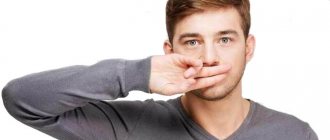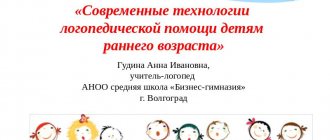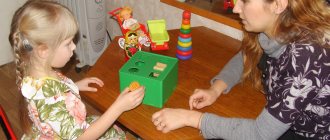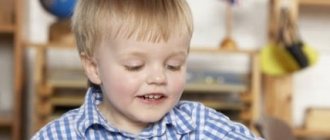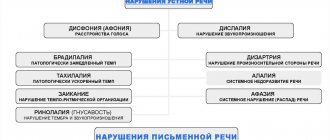Examination card for a patient with aphasia
Card of examination of a patient with aphasia.
Patient's profile
- Preliminary conversation with the patient
FULL NAME___________________________________________________________
Date of Birth_____________________________________________________
Home address____________________________________________________
What time of year is it? _____________________________________________
What education do you have _____________________________________________
Date of illness________________________________________________
Where do you work __________________________________________________
How do you feel____________________________________________
Date of filling out the speech card ________________________________________________
Speech therapist:___________________________________________________________
Data from examination of nonverbal mental functions
II. Examination of non-speech gnosis and praxis
1. Study of motor functions of the hand:
A) List fingers_______________________________________________
Touch your fingers ________________________________________________
Move your fingers together ________________________________________________
Clench and unclench the fingers of both hands ___________________________________
B) Study of postural praxis:
Show 2nd and 3rd fingers, 2nd and 5th fingers ___________________________________
Place the 2nd and 3rd fingers into a ring _____________________________________________
C) Study of the dynamic organization of the motor act:
Fist, ring ______________________________________________________________
2. Study of oral praxis:
A) Extend your lips_________________________________________________________
B) Bare your teeth_________________________________________________________
C) Show your tongue with a spatula/roll it into a tube _____________________
D) Puffing up the cheeks_________________________________________________________
D) Place your tongue between your lips_____________________________________________
E) Place your tongue between your teeth_____________________________________________
G) Study of the dynamic organization of oral movements, perform 3-4 exercises in a row:
Stick your tongue out with a spatula, bare your teeth, puff out your cheeks, place your tongue between your teeth ____________________________________________________________
3. Study of speech regulation of motor act
A) Draw simple figures_____________________________________________
B) A series of simple geometric shapes______________________________
Conclusion:______________________________________________________________________________________________________________________
__________________________________________________________________
________________________________________________________________________________________________________________________________
III. Auditory-motor coordination research
1. Study of the perception and reproduction of pitched musical melodies:
A) Differentiation by height of two sounds ___________________________________
B) Perception and reproduction of pitched musical melodies___________________________________________________________
2. Study of perception and reproduction of rhythmic structures:
A) Tapping simple rhythms (single beats)____________________
B) Tapping a series of rhythms (two strong, two weak beats) ___________
C) Multiple repetition of rhythms (two strong, two weak, two fast, one delayed)_____________________________________________
Conclusion: ______________________________________________________
____________________________________________________________________________________________________________________________________
IV. Visual Perception Research
1. Presentation of objects or their images:
A) Name the object/image ___________________________________
B) Describe the object/image ___________________________________
2. Complex or insufficiently clear images of objects are presented:
A) Name the individual details of the depicted object _________________
3. Crossed out, noisy or superimposed objects are presented:
A) Name the crossed out image ________________________________
B) Describe the crossed out image ________________________________
B) Name the superimposed objects__________________________________________
D) Rowena's test _____________________________________________________
Conclusion: ______________________________________________________
____________________________________________________________________________________________________________________________________
V. Study of orientation in space
1. A number of graphic samples are presented:
A) Show right and left hands__________________________________________
B) Show objects in front, behind, left, right, above, below in relation to yourself________________________________________________
C) Folding stick figures according to a pattern, from memory _________________
2. Tests with a clock:
A) Place the clock hands at the indicated time ________________________
3. Compare whether the letters and numbers are written correctly or not:
A) Recognition of letters written in different fonts _______________________
B) Comparison of the correct spelling of letters and numbers in a mirror arrangement _______________________________________________________
Conclusion:________________________________________________________________________________________________________________________________________________________________________________________
Features of speech
VI. Impressive Speech Research
1. Study of phonemic hearing:
A) Repeat the sounds: b, r, m, d, k, s, n __________________________________
B) Repeat close oppositional phonemes: ba-pa, pa-ra, da-ta, da-ta-da ________________________________________________________________
C) Repeat the pairs of sounds: p-b, b-p, g-k, k-g, l-r, r-l _____________________
D) Repeat a series of 3 sounds: a-u-o, u-a-i, b-r-k, m-s-d _______________
E) Repeat a series of 3 sounds (close sounds): b-p-b, p-b-p, d-t-d, t-d-t ________________________________________________________________
E) Show the sounds on the split alphabet: d, n, s, b, k, m, r ___________________
G) When pronouncing the sound “B”, raise your hand, when pronouncing the sound “P”, keep your hand on the table________________________________________________
2. Study of word understanding:
A) Show the objects in the pictures, which I will name in the correct sequence: sofa, TV, table, refrigerator, etc.____________________________________________________________
B) Show the objects that are on the table in the correct sequence ________________________________________________
C) Show in the correct sequence: ear, eye, ear, nose________________________________________________________________
D) Find the picture that I name (from 3, from 5, from 7) __________________
D) What does the word “cat” mean?_____________________________________________
What does the word “tree” mean?________________________________________________
What does the word “celandine” mean? ________________________________________________
E) Auditory differentiation of words of quasi-homonyms:
Repeat after me: mouse - bowl, scythe - goat, duck - fishing rod, barrel - kidney, grass - firewood_________________________________________________
3. Study of understanding simple sentences:
A) It is proposed to perform three actions in one request
— Take a pencil, put it under the book, and give me the scissors_______________________________________________________________
B) It is proposed to answer questions using picture material
Show us how to cut bread__________________________________________________________
Show what is poured into the teapot _____________________________________
C) It is proposed to perform a test: “conflict situation”.
If it is night, then put “0” in the white square, if it is day, put zero “0” in the black square______________________________
4. Study of understanding of logical and grammatical structures
A) Affective construction: the patient is asked to show two sequentially named objects “brush - pencil”, “pen - notebook”, “ruler - eraser”_____________________________________________
B) The patient is offered the same words, put in the instrumental case: “show the pencil with a brush,” “show the notebook with a pen,” “show the eraser with a ruler.” __________________________________________________________ C) The patient is offered the same words, but the instructions become more complicated and the sequence of words changes: “show with a pencil brush”, “notebook pen”, “eraser ruler”________________________________
D) Understanding the constructions of the attributive genitive case: the patient is offered an image of a mother and daughter, then asked to show where “the daughter’s mother” is and where “the mother’s daughter” is ___________________________________
"Father's Brother"______________________________________________________________
“Brother’s Father”_______________________________________________________________
“Boss’s Brother”________________________________________________________________
“Brother’s boss”________________________________________________________________
E) Understanding prepositional constructions: the patient is asked to put a “cross under a circle”, “a circle above a cross”, “a point under a triangle” ___________________________________________________________________
E) The patient is asked to “put the pen to the right of the ruler and to the left of the pencil”_______________________________________________________
G) The patient needs to determine which of two phrases is correct: “autumn comes before winter,” “winter comes before autumn.”
H) Understanding of comparative constructions: Kolya is taller than Vanya and shorter than Sasha. Who are Kolya, Vanya and Sasha here? (carried out on painting material)______________________________________________________________
I) Understanding of inverted grammatical structures: “Petya hit Kolya. Who’s the fighter?”_______________________________________________
Conclusion: ______________________________________________________
____________________________________________________________________________________________________________________________________
VII. Expressive Language Research
1. State of articulatory motor skills.
- Movements of the lower jaw:
Open and close your mouth_______________________________________________ Open and close your mouth, overcoming the resistance of your palm______________
move the lower jaw left and right ___________________________________
- Lip movements:
stretch your lips into a “smile”___________________________________________ stretch your lips forward in a “tube”____________________________________
alternate performing these exercises
raise the upper lip, exposing the upper teeth____________________ lower the lower lip, exposing the lower teeth__________________________
- Tongue movements:
show a wide tongue - “scapula”________________________________
show a narrow tongue - “sting” _____________________________________
alternate exercises___________________________________________
"swing"___________________________________________________________
pendulum"__________________________________________________________"delicious jam"________________________________________________
— Movements of the soft palate:
Open your mouth wide and yawn_____________________________________________
A jerky pronunciation of the letter “A” with a firm attack of the voice with the mouth wide open.
Conclusion: (presence or absence of movements, tone, volume, ability to switch, substitutions, synkinesis, tremor, abundant salivation, deviation of the tip of the tongue - filled in after test exercises) ________________________________________________________________________________________________________________________________________________________________________________________________________________________________________________________________________________________________
2. Study of articulation of speech sounds, isolated: the patient is asked to repeat
CM______________________________________________________________
Z, B ______________________________________________________________
S, B_________________________________________________________________
A, U ______________________________________________________________
Зь, Мь_______________________________________________________________
W, D ________________________________________________________________
Shch, L ______________________________________________________________
F, D ____________________________________________________________
Ch, L ______________________________________________________________
R, Кь______________________________________________________________
Ry, Hy ____________________________________________________________
OK ______________________________________________________________
Oh, Y_______________________________________________________________
Ть, В ______________________________________________________________
Gy, P_______________________________________________________________
X, T ______________________________________________________________
J, P ______________________________________________________________
N, V ______________________________________________________________
Нь,Ф_______________________________________________________________
F, G______________________________________________________________
I, E ______________________________________________________________
3. Study of conjugate and reflected speech:
A) The patient is asked to listen first and then repeat
Table, cake, current, wolf, dream__________________________________________
Pipe, bag, vase, pie, path. ___________________________________
Road, pie, feather bed, nettle, runner _________________________
Curtain, parachutist, tape recorder, polar region ______________________
Academics, Mathematics, Behavior, Learning__________________________
D) The patient is asked to first listen and then repeat:
The girl ran to her room__________________________________________
She works at the post office ___________________________________
Clouds run across the clear sky ___________________________________
The wind tears lonely leaves from the trees ___________________________
Bunches of rowan berries turn red in sunny meadows ________________________
A strong snowstorm whistles in winter_____________________________________________
4. Study of the nominative function of speech.
A) Names of body parts and objects (on the patient, on objects, carried out on picture material).
| Nose - | Belly - | Hands - | Seat - | Steering wheel |
| Mouth - | Breast - | Collar - | Back - | Headlights |
| Neck - | Back of the head - | Buttons - | Legs - | |
| Ears - | Palm - | Lightning - | Cabin - | |
| Eyes - | Temple - | A loop - | Body - | |
| Head - | Legs - | Sleeve - | Wheels - |
B) General concepts:
Potatoes, tomatoes, cabbage_______________________________________________
Pear, apple, orange___________________________________________
Doll, pyramid, ball, cubes_____________________________________________
Pants, skirt, jacket_______________________________________________
Cup, ladle, pan_______________________________________________
Saw, hammer, screwdriver__________________________________________________________
Bed, wardrobe, table_______________________________________________
Plane, car, bus__________________________________________________________
Shoes, boots, felt boots_______________________________________________
Crow, titmouse, sparrow__________________________________________
Cow, pig, chicken__________________________________________________________
Fox, squirrel, hare_________________________________________________
Birch, rowan, spruce________________________________________________
C) Name of professions: what does a doctor, hairdresser, teacher, fireman, salesman, dentist, cook, postal worker, seamstress do? ________________________________________________________________
5. Study of narrative speech.
A) The patient is asked to list a number series from 1 to 10 ___________________________________________________________________
List the days of the week _____________________________________________
List months ________________________________________________
B) The patient is offered an analysis of dialogical speech: first, the patient is asked questions that have an answer (did you have lunch today?)___________________________________________________________
B) The patient is asked questions that have no answer (What did you watch on TV today?)___________________________________________
D) Independent productive narrative speech is examined: the patient is asked to tell the content of the pictures shown or retell the text he just heard _____________________________________________________________________________________________________________________________________
6. The ability to operate with complex grammatical statements is studied.
A) The patient is given written sentences and asked to insert the missing word:
There were a lot of mushrooms in the Machine ________.
The snow fell in large ________.
Dry _______ rustle underfoot.
B) The patient is given three isolated words from which he must make a sentence: forest, umbrella, rain ________________________________________________________________________________________________________________________________
C) The patient is given a ready-made phrase with a broken word order, he needs to create the correct order: appeared, forest, thawed patches, only, in ___________________________________________________________________
Conclusion: ______________________________________________________________
______________________________________________________________________________________________________________________________________________________________________________________________________
Written speech
VII. Reading and Writing Research
1. Study of sound analysis and synthesis of words.
A) It is proposed to determine the number of sounds in simple words: cat, sleep, cancer, nose, weight __________________________________________________________
-Determination of the number of sounds in a word: bagel, tree, flower, glass
__________________________________________________________________
B) It is proposed to isolate individual sounds from words:
-What is the first sound in the word “Cat”_____________________________________________
-What is the 2nd sound in the word “Table” _______________________________________
-What is the 3rd sound in the word “Spider”__________________________________________
C) The position of sound in words is studied:
What is the sound after the sound “m” in the word “lump” ___________________________
What is the sound after the “t” sound in the word “ceiling”___________________________
What is the sound after the “v” sound in the word “cook”___________________________
D) Study of sound synthesis:
- Name the spoken word syllable by syllable (syllable synthesis)
Bed________________________________________________________
Parachute______________________________________________________
Pan_______________________________________________________
Car__________________________________________________________
Square_________________________________________________________________
Name a sentence pronounced according to words (syllable synthesis)
There is a flower growing in the pot___________________________________________
there's a cat lying on the window ____________________________________________
in the forest there were flowers under the snow___________________________
the sun is shining outside the window_______________________________________
2. Study of writing.
A) Copying letters, syllables, words _____________________________________________________________________________________________________________________________________
B) The patient is asked to write his full name. __________________________________________________________________
C) Write individual sounds from dictation, short words (house, ear, window):
____________________________________________________________________________________________________________________________________
D) Writing a dictation of phrases and sentences (Children go to the forest. The weather is bad outside. The journey ended well)
____________________________________________________________________________________________________________________________________
D) It is proposed to list the surrounding objects in writing
______________________________________________________________________________________________________________________________________________________________________________________________________
E) It is proposed to write about a work he has read or about what he has been doing in recent days ________________________________________________________________________________________________________________________________________________________________________________________________________________________________
3. Reading study.
A) It is suggested to look at the image of the letters written in a written font, shaded, crossed out and name them ________________________________________________________________________________________________________________________________________________________________________________________________________________ B) Reading syllables (open, closed, with confluence) and words (simple, complex): _____________________________________________________________________________________________________________________________________
C) Complicated reading: the patient is asked to read words crossed out with strokes_________________________________________________________
D) Reading phrases and whole text:
____________________________________________________________________________________________________________________________________________________________________________________________________
Conclusion: __________________________________________________________________________________________________________________________________________________________________________________________________________________________________________________________________________________________________________________________________________
Speech therapy conclusion:
____________________________________________________________________________________________________________________________________
________________________________________________________________________________________________________________________________________________________________________________________________________________________________________________________________________________________________________________________________________________________________________________________________________________________________________________________________________________________________________________________________________________________________________________________________________________________________________________________________________________________________________________________________________________________________________________________________________________________________________________________________________________________________________________________________________________________________________________________________________________________________________________________________________________________________
Date _______________ Speech therapist __________________
Childhood aphasia
The typical age for childhood aphasia is 3-7 years. However, in many cases, the time of onset of the disease depends on the moment at which the etiological factor acted - a hematoma occurred or an injury occurred. Depending on speech and non-speech symptoms, as well as the location of the lesion, in pediatrics and speech therapy the following forms of structural childhood aphasia are distinguished: acoustic-gnostic or sensory, acoustic-mnestic, afferent and efferent motor, dynamic. The semantic form present in adults is not observed in childhood, since in this period the system of symbolic-sign generalization of signals has not yet been formed.
Acoustic-gnostic
or sensory form. The affected area is the posterior 1/3 of the superior temporal gyrus of the left half of the brain. This form of childhood aphasia occurs due to impairments in the acoustic analysis and processing of speech sounds, which is characterized by damage to phonemic hearing. Clinically manifested by a violation of all forms of oral and written speech, reading and mental calculation, rhythmic reproduction. Also, such children experience excessive anxiety and excitability, and emotional instability.
Acoustic-mnestic aphasia
. Localization of the lesion is the middle and posterior parts of the temporal region. The essence of this childhood aphasia is increased inhibition of auditory traces, leading to impairment of auditory and speech memory. There is also a defect in visual and object images and representations. Such children do not understand subtext, allegories, and cannot name objects. There is a moderate impairment of oral speech and its perception. Increased activity and emotional instability and anxiety may occur.
Afferent motor aphasia
. The location of the lesion is the lower parietal areas of the dominant hemisphere. Pathogenetically based on disorders of kinesthetic perception. The main symptom is anomalies of small articulatory movements of the lips and tongue. Such children are either incapable of expressive speech or have a large number of literal paraphasias. Involuntary and automated (songs, poems) speech, writing and reading are preserved.
Efferent motor form
childhood aphasia. In this form, the posterior frontal areas are affected. The inertia of formed stereotypes suffers, which is manifested by perseverations. The ability to express verbally is minimal or completely absent. Individual sounds and automated speech can be stored. There is a violation of reading, writing, and apraxia.
Dynamic aphasia
. An extremely rare form in pediatrics, it can be observed in children of older age groups. Localization of the pathological focus is the posterior frontal regions. Pathogenetically, this type of disease is caused by defects in internal speech and a violation of the successive organization of speech. It manifests itself as a disorder of productive speech, an inability to actively communicate - normal sentences are replaced by stereotypes or templates, verbs are completely absent. Patients with this form of childhood aphasia almost never ask anything or engage in dialogue, but willingly answer the questions posed. Reading and writing can be saved.
Landau-Kleffner syndrome
. The localization of paroxysmal activity can be different; the temporal regions are most often affected. Loss of speech can occur either abruptly (most often) or gradually over several months. The ability to perceive speech is also lost, and behavioral and emotional disorders are possible - hyperexcitability, emotional lability. A characteristic feature of this form of childhood aphasia is convulsive seizures, which, however, are not observed in all patients.
